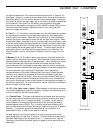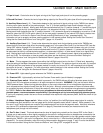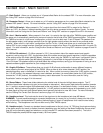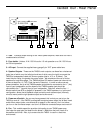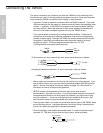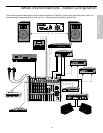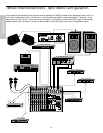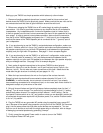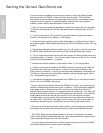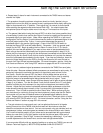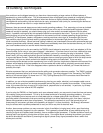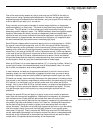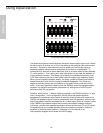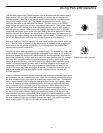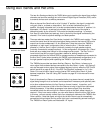
15
Setting up your TM500 is a simple procedure which takes only a few minutes:
1. Remove all packing materials (save them in case of need for future service) and
decide where the TM500 is to be physically placed. Make sure that the rear vent and fan
are unobstructed and that there is good ventilation around the entire unit.
2. Before even plugging the TM500 into an AC socket, begin by making its speaker
connections. It is never a good idea to power up any amplifier that is not connected to
loudspeakers. Any loudspeakers with a minimum impedance load of 4 ohms (that is,
4 ohms or greater) can be used, but we recommend the use of 4 ohm speakers for long-
term usage. In order to ensure correct phase correlation, be sure that the connection
from the tip of the TM500 speaker jack goes to the “+” (hot) input of your loudspeaker,
and that the sleeve of the TM500 speaker jack is connected to the “-” (ground) input of
your loudspeaker.
2a. If you are planning to use the TM500 in a standard stereo configuration, make sure
the Aux 1 / Monitor switch is in its up (“out”) position and make connections between the
left speaker output(s) and your left main PA speaker(s) and between the right speaker
output(s) and your right main PA speakers. See page 11 for an example diagram.
2b. If you are planning to use the TM500 in a “split mono” configuration, make sure the
Aux 1 / Monitor switch is pressed in (“on”) and make connections between the left
speaker output(s) and your main PA speaker(s) and between the right speaker output(s)
and your onstage monitors. See page 12 for an example diagram.
3. Next, make all required connections to the various TM500 line-level outputs
(Record Out, Mono Out, and Aux Sends 1 and 2) and line-level inputs (Tape In, Aux
Returns 1 and 2). Do not make any insert connections at this time—these should be
made after the gain structure is correctly set (see pages 14 - 15).
4. Make the input connections to the mic or line inputs of the various channels.
Stereo line-level signals should be connected to stereo channels 9/10 and 11/12.
WARNING: In mono channels, do not connect a channel’s line input if you already
have something connected to its microphone input, or vice versa; each mono channel is
designed to accept only one source or the other.
5. Bring all channel faders and the left-right stereo faders completely down (to their “∞”
setting). Turn all mono channel Trim controls fully counterclockwise, to their “∞” setting
and set both stereo channel Trim switches to their leftmost “+4 dB” setting. Set the
front-panel Phantom switch to its “off” (out) position unless you are absolutely certain that
all connected microphones require 48 volt phantom power; if so, set the Phantom switch
to its “on” (in) position.
6. Plug the TM500 into any grounded AC socket using the supplied heavy gauge IEC
cord. Because of the special relay protection circuitry built into the TM500, you can even
plug it into the same power strip that other audio devices are connected to. You can
then turn on all devices at once with the single power strip on-off switch, with no danger
of damaging connected speakers by generating “thumps.”
7. Finally, press the rear panel Power switch in order to turn on the TM500.
The front-panel Power LED will go on.
Setting Up and Using The TM500
ENGLISH



